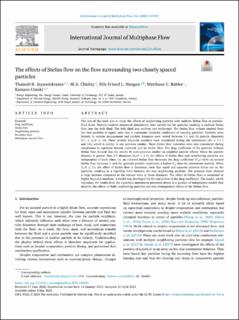| dc.contributor.author | Jayawickrama, Thamali R. | |
| dc.contributor.author | Chishty, Muhammad Aqib | |
| dc.contributor.author | Haugen, Nils Erland L | |
| dc.contributor.author | Bäbler, Matthâus Ulrich | |
| dc.contributor.author | Umeki, Kentaro | |
| dc.date.accessioned | 2023-06-08T09:28:35Z | |
| dc.date.available | 2023-06-08T09:28:35Z | |
| dc.date.created | 2023-06-05T14:28:14Z | |
| dc.date.issued | 2023 | |
| dc.identifier.issn | 0301-9322 | |
| dc.identifier.uri | https://hdl.handle.net/11250/3070507 | |
| dc.description.abstract | The aim of the work was to study the effects of neighboring particles with uniform Stefan flow in particle–fluid flows. Particle-resolved numerical simulations were carried out for particles emitting a uniform Stefan flow into the bulk fluid. The bulk fluid was uniform and isothermal. The Stefan flow volume emitted from the two particles is equal, such that it represents idealized conditions of reacting particles. Particles were located in tandem arrangement and particle distances were varied between 1.1 and 10 particle diameters (1.1≤L/D≤10). Three particle Reynolds numbers were considered during the simulations (Re=2.3,7 and 14), which is similar to our previous studies. Three Stefan flow velocities were also considered during simulations to represent inward, outward, and no Stefan flow. The drag coefficient of the particles without Stefan flow showed that the results fit with previous studies on neighbor particle effects. When the particle distance is greater than 2.5 diameters (L/D>2.5), the effects of Stefan flow and neighboring particles are independent of each other. I.e. an outward Stefan flow decreases the drag coefficient (CD) while an inward Stefan flow increases it and the upstream particle experience a higher CD than the downstream particle. When L/D≤2.5, the effect of Stefan flow is dominant, such that equal and opposite pressure forces act on the particles, resulting in a repelling force between the two neighboring particles. The pressure force showed a large increase compared to the viscous force at these distances. The effect of Stefan flow is weakened at higher Reynolds numbers. A model was developed for the calculation of the drag coefficient. The model, which reproduce the results from the numerical simulations presented above, is a product of independent models that describe the effects of both neighboring particles and two distinguished effects of the Stefan flow. © 2023 The Author(s) | en_US |
| dc.description.abstract | The effects of Stefan flow on the flow surrounding two closely spaced particles | en_US |
| dc.language.iso | eng | en_US |
| dc.publisher | Elsevier | en_US |
| dc.rights | Navngivelse 4.0 Internasjonal | * |
| dc.rights.uri | http://creativecommons.org/licenses/by/4.0/deed.no | * |
| dc.title | The effects of Stefan flow on the flow surrounding two closely spaced particles | en_US |
| dc.title.alternative | The effects of Stefan flow on the flow surrounding two closely spaced particles | en_US |
| dc.type | Peer reviewed | en_US |
| dc.type | Journal article | en_US |
| dc.description.version | publishedVersion | en_US |
| dc.rights.holder | The Authors | en_US |
| dc.source.volume | 166 | en_US |
| dc.source.journal | International Journal of Multiphase Flow | en_US |
| dc.identifier.doi | 10.1016/j.ijmultiphaseflow.2023.104499 | |
| dc.identifier.cristin | 2151956 | |
| dc.relation.project | Norges forskningsråd: 267916 | en_US |
| dc.relation.project | EC/H2020/764697 | en_US |
| dc.relation.project | Sigma2: NN9405K | en_US |
| dc.source.articlenumber | 104499 | en_US |
| cristin.ispublished | true | |
| cristin.fulltext | original | |
| cristin.qualitycode | 1 | |

